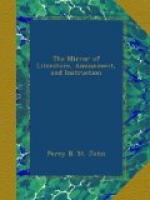“Eclipse was withheld from the course till he was five years of age, and was first tried at Epsom. He had considerable length of waist, and stood over a large space of ground, in which particular he was an opposite form to the flying Childers, a short-backed, compact horse, whose reach lay in his lower limbs; but, from the shape of his body, we are inclined to believe that Eclipse would have beaten Childers in a race over a mile course with equal weights.
“He once ran four miles in eight minutes, carrying twelve stone, and with this weight Eclipse won eleven King’s plates. He was never beaten, never had a whip flourished over him, or felt the tickling of a spur; nor was he ever for a moment distressed by the speed or rate of a competitor; out-footing, out-striding, and out-lasting, (says Mr. Lawrence) every horse which started against him.
“Colonel O’Kelly prized this horse so highly, and treated him with so much kindness, that upon his removal from Clay-hill to Cannons, he had a carriage built for conveying Eclipse to his new abode, his feet being, at the close of his life, too tender for walking. The carriage was something like a covered wagon, but not so wide, and was drawn by two horses. Eclipse stood in the carriage with his head out of a window, made for that purpose, and in this situation many of the inhabitants saw him pass through the town, from one of whom we received our information. This celebrated racer died in February 1789, aged twenty-five years.
“When the races on Epsom Downs were first held periodically, we have not been able to trace with accuracy; but we find that from the year 1730, they have been annually held in the months of May or June, and about six weeks previously to which, the hunter’s stakes are occasionally run for on the Epsom race course, at one of which, in 1730, the famous horse, Madcap, won the prize, and proved the best plate horse in England.
“The races were for a long period held twice in every year, Spring and Autumn; it was then customary to commence the races at eleven o’clock in the forenoon, and after the first or second heat, the company usually returned into the town to dinner. In the afternoon they again assembled on the downs, and the races for the day were then finished.
“This arrangement has been long discontinued, and the races are now annually held on the downs, adjoining the town, on the Wednesday, Thursday, and Friday immediately preceding Whitsuntide, except when Easter Monday happens in March; in which case the races are held a fortnight later than usual, in pursuance of certain regulations agreed upon for holding the principal races in the kingdom.
“This has been the practice here since the celebrated Derby and Oaks Stakes were first established at Epsom, the former in 1780, and the latter in 1779.[8]
[8] A second meeting is held in the autumn.
“Several members of the royal family, and most of the nobility attend these races; and, if the weather be fine, there are seldom less than 60,000 persons assembled here on the Thursday, when the Derby stakes are contested. Of these the vicious and unprincipled form a tolerable proportion; nor is it indeed surprising, where 60,000 persons are assembled to witness a horse race, that these should obtrude themselves, either with the view of propagating vice, or robbing the bystanders.”




